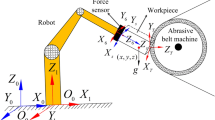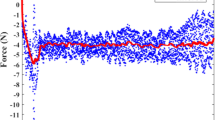Abstract
Industrial-robot assisted abrasive cloth wheel polishing blades aim to reduce surface roughness and improve machining consistency of blades. Since the blade is the complex free-form surface, the blade surface after offline programming has “over-polishing,” “under-polishing,” and machining allowance uneven phenomenon. In this paper, fuzzy impedance force control technology is proposed to solve the precision problem in the blade polishing process. First, the position-based impedance control algorithm is analyzed, and reasonable impedance parameters are obtained based on the actual robot model. Then, the fuzzy variable impedance control combining fuzzy theory and impedance control is proposed to solve the problems of poor trajectory tracking ability and force instability, when the traditional impedance control faces environmental changes and unknown environments. Finally, the simulation platform is built with the help of MATLAB Simulink tool to verify the effectiveness and rationality of the strategy, and the comparative experiment is conducted for robot-assisted abrasive cloth wheel polishing blade under fuzzy variable impedance force control and without force control. The results show that after superimposing the displacement compensation controlled by the fuzzy variable impedance force on the blade surface, the blade surface roughness is below 0.4 μm, the polishing machining allowance is within ± 0.06 mm, and the uniformity and consistency of the blade polishing surface are better.























Similar content being viewed by others
Data availability
All data generated or analyzed during this study are included in this published paper.
Code availability
Not applicable.
References
Whitney DE (1969) Resolved motion rate control of manipulators and human prostheses. IEEE Trans Man-Mach Syst 10(2):47–53
Mohammad AEK, Hong J, Wang DW et al (2018) Design of a force-controlled end-effector with low-inertia effect for robotic polishing using macro-mini robot approach. Robot Comput Integr Manuf 49:54–65. https://doi.org/10.1016/j.rcim.2017.05.011
Liu XN, Zhang T, Li J, et al (2018) A novel end-effector for robotic compliant polishing, 2018 IEEE Inter Confer on Robotics Biomimetics (ROBIO). IEEE, 1858-1863. https://doi.org/10.1109/ROBIO.2018.8665197
Liu XN, Zhang T, Li J, et al (2018) A new design of flexible constant force polishing head and experimental verification. 2018 IEEE International Conference on Information and Automation (ICIA). IEEE 1146–1151. https://doi.org/10.1109/ICInfA.2018.8812549
Lopes A, Almeida F (2008) A force-impedance controlled industrial robot using an active robotic auxiliary device. Robot Comput Integr Manuf 24:299–309. https://doi.org/10.1016/j.rcim.2007.04.002
Chen F, Zhao H, Li DW et al (2019) Contact force control and vibration suppression in robotic polishing with a smart end effector. Robot Comput Integr Manuf 57:391–403. https://doi.org/10.1016/j.rcim.2018.12.019
Chen F, Zhao H, Li DW et al (2019) Robotic polishing of a blisk with two degree of freedom contact force control. Int J Adv Manuf Tech 101(1–4):461–474. https://doi.org/10.1007/s00170-018-2925-6
Hogan N (1985) Impedance control - an approach to manipulation. I - Theory. II - Implementation. III – Applications. J Dyn Syst Meas Contr 107:1–24
Xu XH, Chen W, Zhu DH, Yan SJ, Ding H (2021) Hybrid active/passive force control strategy for polishing marks suppression and profile accuracy enhancement in robotic belt polishing of turbine blade. Robot Comput Integr Manuf 67:102047. https://doi.org/10.1016/j.rcim.2020.102047
Duan JH, Zhang YM, Shi YY (2016) Belt polishing process with force control system for blade of aero-engine. Proc I MechE Part B: J Eng Manuf 230 (5):858-869
Zhang HY, Li L, Zhao JB et al (2021) The hybrid force/position anti-disturbance control strategy for robot abrasive belt polishing of aviation blade base on fuzzy PID control. Int J Adv Manuf Technol 114:3645–3656. https://doi.org/10.1007/s00170-021-07122-2
Seraji H, Colbaugh R (1993) Force tracking in impedance control. Robot Autom, Int Conf IEEE. https://doi.org/10.1109/ROBOT.1993.291908
Burn K, Short M, Bicker R et al (2003) Adaptive and nonlinear fuzzy force control techniques applied to robots operating in uncertain environments. J Robot Syst 20(7):391–400. https://doi.org/10.1002/rob.10093
Chen P, Zhao H, Yan X, Ding H (2019) Force control polishing device based on fuzzy adaptive impedance control. In: Yu H, Liu J, Liu L, Ju Z, Liu Y, Zhou D. Intelligent Robotics and Applications. ICIRA 2019. Lecture Notes in Computer Science, vol 11743. Springer, Cham. https://doi.org/10.1007/978-3-030-27538-9_-16
Xian JS, Xi Z et al (2018) Fuzzy adaptive hybrid impedance control for mirror milling system. Mechatronics 53:20–27. https://doi.org/10.1016/j.mechatronics.2018.05.008
Mallapragada V, Erol D, Sarkar NA et al (2007) New method of force control for unknown environments. Int J Adv Robotic Systems 4(3):4509–4514. https://doi.org/10.1109/IROS.2006.282089
Yang ZQ, Peng JZ, Liu YH (2019) Adaptive neural network force tracking impedance control for uncertain robotic manipulator based on nonlinear velocity observer. Neurocomputing 331(28):263–280. https://doi.org/10.1016/j.neucom.2018.11.068
Ravandi A, Karamali K, Esmaeel D et al (2018) Hybrid force/position control of robotic arms manipulating in uncertain environments based on adaptive fuzzy sliding mode control. Appl Soft Comput 70:864–874. https://doi.org/10.1016/j.asoc.2018.05.048
Ghajar MH, Keshmifi M, Bahrami J et al (2018) Neural-network-based robust hybrid force/position controller for a constrained robot manipulator with uncertainties. Trans Institute Meas Control 40(5):1625–1636. https://doi.org/10.1177/0142331216688524
Zhang T, Ye Y, Yan B et al (2019) An adaptive sliding-mode iterative constant-force control method for robotic belt polishing based on a one-dimensional force sensor. Sensors 19(7):1635. https://doi.org/10.3390/s19071635
Xu XH, Zhu DH, Zhang HY et al (2019) Application of novel force control strategies to enhance robotic abrasive belt polishing quality of aero-engine blades. Chin J Aeronaut 32(10):2368–2382. https://doi.org/10.1016/j.cja.2019.01.023
Jung S, Hsia TC, Bonitz RG (2004) Force tracking impedance control of robot manipulators under unknown environment. IEEE Trans Control Syst Technol 12(3):474–483. https://doi.org/10.1109/TCST.2004.824320
Brancati R, Russo R, Savino S (2010) Method and equipment for inertia parameter identification. Mech Syst Signal Process 24(1):29–40. https://doi.org/10.1016/j.ymssp.2009.06.008
Funding
This work was supported by the National Natural Science Foundation of China (Grant No. 52105474) and the Science and Technology Innovation Project of Colleges and Universities in Shanxi Province (Grant No.RD2000003620).
Author information
Authors and Affiliations
Contributions
The proposal and realization of this technology were mainly completed by Jia Liu. Shengqiang Yang provided experimental conditions and guidance on research directions. Jingjing Zhang participated in technical discussions and research. Other authors participate in the research.
Corresponding authors
Ethics declarations
Ethical approval
Not applicable.
Consent to participate
Not applicable.
Consent to publication
Not applicable.
Competing interests
Financial interests: Author Jia Liu have received research support from the funding.
Non-financial interests: Authors Jingjing Zhang and Jingzheng Li, Shengqiang Yang, Zhijie Qiao Chun Ju, Xuhui Zhao did not get paid from the funding.
Additional information
Publisher's note
Springer Nature remains neutral with regard to jurisdictional claims in published maps and institutional affiliations.
Rights and permissions
Springer Nature or its licensor (e.g. a society or other partner) holds exclusive rights to this article under a publishing agreement with the author(s) or other rightsholder(s); author self-archiving of the accepted manuscript version of this article is solely governed by the terms of such publishing agreement and applicable law.
About this article
Cite this article
Liu, J., Zhang, J., Li, J. et al. Research on fuzzy impedance force control technology of robot-assisted abrasive cloth wheel polishing blade. Int J Adv Manuf Technol 127, 2537–2551 (2023). https://doi.org/10.1007/s00170-023-11648-y
Received:
Accepted:
Published:
Issue Date:
DOI: https://doi.org/10.1007/s00170-023-11648-y




